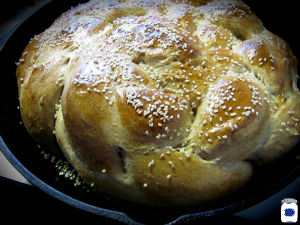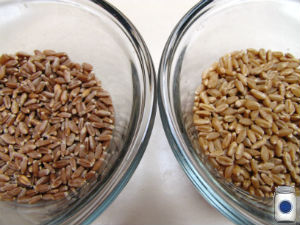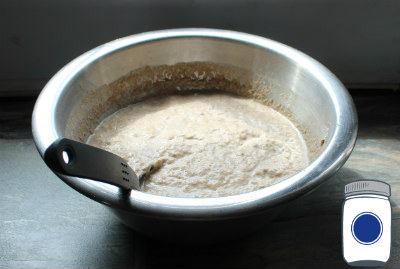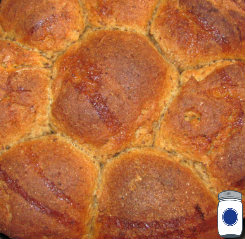Pre-Ferments
Choosing which kind to use & other factors to consider
So what are the different kinds of pre-ferments?
Generally, a bread baker will have four traditional pre-ferments divided in two broad categories to choose from: the first being a firm or dry pre-ferment and the second is a wet or sponge pre-ferment (Reinhart, p. 52-53).

Pâte Fermentée (Firm/Dry style) is so named in the European tradition of calling things what they are, “old dough” or “pre-ferment.” Rossada has this to say about it, “Pre-fermented dough (or old dough) is a fairly new method. Originally, this preferment had been developed to compensate for the mediocre quality of bread produced by the straight dough process with a short first fermentation.”
If you are thinking, “Wow, that sounds a lot like San Francisco sourdough starter to me,” you would be (partially) correct. Before refrigeration, folks had to resort to indirect dough—the good news is that it caught on! However, sour dough depends on wild yeast or more specifically Saccharomyces exiguus where as San Francisco sour dough starter is made using Lactobacillus sanfrancisco—no, seriously (Reinhart p. 65). The magic here is in running two processes in series to maximize the effect on the bread with only your time spent in making the bread.

Biga (Firm/Dry style) is a lot like the “old dough” method above, but the Italians gave us this one with the biggest difference being the absence of salt. The formula for this stiff pre-ferment would be 50/55-1/.5 (flour, water, very little yeast). Where pâte fermentée can be a leftover scrap added to the fresh dough, biga is made purposely as a pre-ferment or starter dough.
Because of the very stiff consistency and the cooler fermentation, biga provides a lot of strength to the dough, which was its original purpose. Today with stronger flour, bakers must be careful to use the biga properly, or the added strength could penalize extensibility in the dough. The advantages of a properly fermented biga are similar to other methods: better flavor and extended shelf life. (Rossada).
Poolish (Wet/Sponge style) is a name that gives us a glimpse into the depths of the French language. Most of bread baking tradition comes from Europe and principally the French, so they get to name things.
Poolish is a term that was coined by the French to honor the Polish bakers who, centuries ago, taught them this technique for improving bread. . . . The wet sponge offers far less resistance to fermentation than does firm dough, so the yeast has an easy time converting the available sugars into carbon dioxide and ethanol (Reinhart, p. 53)
The Poolish formula is very wet using equal parts (that is weight) flour and water with only a pinch of fresh yeast (100-.25) giving a consistency somewhere between lemon meringue and melted ice cream. Rossada offers a more precise scale for the fresh yeast (not instant) used for this pre-ferment based on the time that you are allowing it to work:
Fermentation time 3 hours 7-8 hours 12-15 hours
Quantity of yeast 1.5% .7% .1%
The final dough mixed with Poolish will require additional yeast to complete the rise, but the flavor imparted is remarkable because the flavor comes from the grain. If you were making an enriched bread recipe, the yeast is feeding off of the sugar added to the dough (causing a rise) instead of the natural wheat. With the use of a pre-ferment you taste the converted sugar in the grain.

Levain Levure (Wet/Sponge style) is French for “leaven of the yeast.” Yep, the Europeans called it like they saw it once more, and this name is also interchangeable with the “sponge” pre-ferment. The sponge has its own unique qualities and has been largely replaced in commercial baking by the shelf stable “bread” you find in the plastic tube on the grocery store shelf. These shelf stable “breads” require dough enhancers which all have really long names that are foreign to any home kitchen, so please stick with a time tested pre-ferment (such as a true levain) if you want to bake amazing bread at home and skip the tube.
Levain and Sourdough have many similarities and are sometimes mixed terminology. They both have this in common—you can perpetuate them and feed them, and even name them if you want—whereas the other pre-ferments are one-time deals. Although you can snag a piece of your favorite Pâte Fermentée to ripen the next day’s bread, it is not really “alive” like Levain/Sourdough.
A regular sponge, on the other hand, is usually faster than a poolish because it front-loads all or most of the yeast in the sponge itself. This kind of sponge, often used in whole grain and rich breads, improves flavor and digestibility of the grain, but in less time than poolish (Reinhart, p. 53).

A simple low-risk experiment that you may wish to try at home is a form of a “soaker” which technically is not a pre-ferment, but does affect the outcome of the final product. The technique is known as the “autolyse” process and Chaya says that it helps tremendously.
- Take your flour and water and mix them in a bowl for four minutes.
- Allow the mixture to rest for approximately twenty minutes, and then mix the rest of the ingredients including the yeast in for the required time.
The big differentiator here is that the yeast is not active to cause a bacteria response, this is simply the water breaking down the fiber somewhat. In either case, gluten and yeast are activated by the water, you are simply staggering those reactions in this method.
Calculations of Yummy Bread
Another wrinkle in the pursuit of great bread is calculating the pre-ferment in the bread formula. If you recall from our blog post on Baking Math, a real bread baker will use something called a formula instead of a recipe. This will vary from recipe to recipe, so be sure to calculate your total flour weight based on whether the recipe calls for the pre-ferment as its own percentage or as a part of the total flour used.
And if that was not enough to think about, the gluten content in the dough will soften as the moisture is absorbed—which may not be surprising to you. However, the higher the dough’s gluten content the more liquid is needed to maintain the consistency due to the absorption. This is in addition to longer mixing times also required to blend the ingredients properly; and mixing is where the gluten is developed into strands.

Yet one more detail to plan around is the use of salt. As you see, salt is highly controlled in pre-ferment products because salt is a counterweight to yeast. If the yeast has more time to work, then you can get away with less of it—stretching your yeast supply out further. This is good news for the thrifty bread baker, better flavor with less consumable yeast.
Baking great bread really comes down to one skill: how to manipulate time and temperature to control outcomes. . . . if the bread is not properly fermented, it can never be better than average. It is in this, the primary fermentation stage that dough is transformed from a lifeless lump of clay into a living organism (Reinhart, p. 59)
In our next blog, we explain the science to all of this, so check it out. If you have any tips or tricks to share with your pre-ferments, leave a comment and share it with us!
Wilson
Pro Deo et Patria
Works Cited:
Reinhart, P. (2002). The bread baker’s apprentice, mastering the art of extraordinary bread. (p. 27). Ten Speed Pr.
Rossada, D. (n.d.). Retrieved from http://www.bakerconnection.com/artisanbaker/article_04.htm
Photo Credits:
Ghirardelli (Factory) by Ghirardelli Chocolate Company taken from http://www.ghirardelli.com/about-ghirardelli
All other Photos by Pantry Paratus
Proviso:
Nothing in this blog constitutes medical advice. You should consult your own physician before making any dietary changes. Statements in this blog may or may not be congruent with current USDA or FDA guidance.

INTERESTED IN LEARNING MORE ABOUT FERMENTATIONS OF ALL TYPES. JUST WANT TO PRODUCE
THE BEST BREADS I CAN. Read Peter Reinhart often.
ALSO interested in bread recipes for people with difficulty with swallowing and saliva {Dry Mouth}
Thank you, looking forward to your comments
Thanks for your comment! Peter Reinhart is a personal favorite around here. My father used to choke nearly every time he ate because of a medical problem, and I understand the need for recipes for people who have difficulty swallowing–it’s hard to get enough fiber because those are the foods most commonly avoided. I haven’t ever researched this, though. It’s an excellent idea. Thanks for the suggestion.
My grandmother use to bake the most incredible tasting bread ever. Unfortunately she passed away over 20 years ago. I have no way of knowing what her bread making methods were. Between the poolish, biga, sponge, and pate’ formentee’ would result in the strongest flavor in loaf or artisan style breads? Thank you for your time